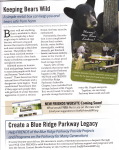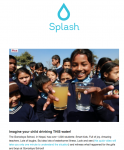What is one of the major revelations my Simple Development Systems’ members point to again and again as having exploded their fundraising?
“Since we’ve increased our donor communications, we’ve tripled our revenue.”
But, here’s the rub: when it comes to donor communications, you need to communicate both frequently and well. Communicating well involves switching from nonprofit jargon speak, to what I call the language of donor love. And communicating often involves scheduling, making a plan, and implementing.
Haphazard communications simply don’t work. You need a system to ensure that you’re ‘touching’ your supporters a bare minimum of 12 times a year. Easier said than done, especially when your days are consumed with putting out fires.
How do you create a plan to communicate consistently and well with your donors and supporters throughout the year…and follow through and actually do it?
Smart fundraisers learn how to template (or systematize) their work. The idea behind a template like my Fundraising Appeal Letter Template (click to download) is to prompt the user to understand tested concepts in direct mail fundraising, and then apply them to fit their donors.
Long before the internet came along, I had a folder on my desk for my organization’s monthly donor newsletter for program and support staff to fill, and I had a simple template as a guideline. Every newsletter included a client story, as well as a donor or volunteer story.
Now, in my current business, I have templates saved in my word pressing software. Templates for client intake calls, a template for my weekly newsletter, a template that ensures that my Basics & More™ courses cover every base.
When it comes to your donor communications: Consistency is key. Consistency in design, consistency in conveying your mission, and consistency in scheduling. And formulas work.
Once you’ve created your rinse-and-repeat systems for better communications, implementing them becomes second nature.
For examples of how other nonprofit organizations are communicating with their donors, you can always refer to my two weekly blog features, What’s in my Inbox, and What’s in my Mailbox. And, check out the following stellar examples of nonprofit newsletters done right:
1. Think print newsletters are passé? Think again. Nashville Rescue Mission, a nonprofit organization serving the homeless, raises $2 million a year from their print newsletter alone. Michelle Sanders  Brinson, an SDS member, and storyteller extraordinaire for Nashville Rescue Mission says “If you are struggling with creative ways to connect with your donors, then Pamela Grow’s newsletter course is just what you need.
Brinson, an SDS member, and storyteller extraordinaire for Nashville Rescue Mission says “If you are struggling with creative ways to connect with your donors, then Pamela Grow’s newsletter course is just what you need.
I took this course last year and was able to immediately put some of the ideas and suggestions I learned from her class to work. Donor-focused newsletters can bring in a lot of funds for your nonprofit if done right. Take this course and start off on the right foot. Otherwise, you’re leaving money on the table.” (Click image to read article)
2. Friends of the Blue Ridge Parkway, another participant in our Nonprofit Newsletters | The Basics & More course, won kudos with their Autumn newsletter.
 Note the strong, vibrant photographs and captions, the focus on the donor, and the legacy gift shout-out.
Note the strong, vibrant photographs and captions, the focus on the donor, and the legacy gift shout-out.
3. Mabee-Gerrer Museum of Art, one of the oldest museums in the state of Oklahoma, and a member of the pilot group of Simple Development Systems, learned how to shift their donor communications to a revenue-producing model. Click here to read how they did it.
 4. And, for email nonprofit newsletters, Splash does it right by keeping it simple and wholly focused on the donor.
4. And, for email nonprofit newsletters, Splash does it right by keeping it simple and wholly focused on the donor.
What the heck is What’s in my Inbox, What’s in my Mailbox, and the Power of Storytelling? Glad you asked. Simple Development Systems is a program for creating your sustainable fundraising by always keeping your donors front and center. It’s a super simple simple rinse-and-repeat system of sharing your gratitude, and your stories – online and off – on a consistent basis. Join us every week for Power of Nonprofit Storytelling (Mondays), What’s in my Inbox (Tuesdays), and What’s in my Mailbox (Wednesdays).

















 I can’t wait to meet with you personally.
I can’t wait to meet with you personally.
Comments on this entry are closed.